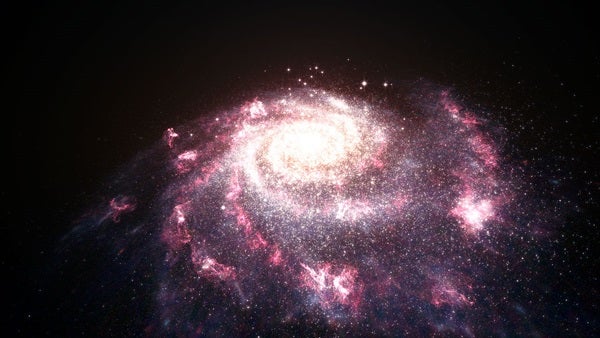When galaxies form new stars, they sometimes do so in frantic episodes of activity known as starbursts. These events were commonplace in the early universe but are more rare in nearby galaxies.
During starbursts, hundreds of millions of stars are born, and their combined effect can drive a powerful wind that travels out of the galaxy. Scientists knew these winds affected the host galaxies, but new research now shows that they have a significantly greater effect than astronomers thought.
An international team observed 20 nearby galaxies, some of which were undergoing starbursts. The researchers found that the accompanying winds could ionize gas up to 650,000 light-years from the galactic center — around 20 times farther out than the visible size of the galaxy. This is the first direct observational evidence of local starbursts impacting the bulk of the gas around a galaxy and has important consequences for how that galaxy continues to evolve and form stars.
“The extended material around galaxies is hard to study, as it’s so faint,” said team member Vivienne Wild of the University of St. Andrews in Scotland. “But it’s important — these envelopes of cool gas hold vital clues about how galaxies grow, process mass and energy, and finally die. We’re exploring a new frontier in galaxy evolution!”
The team used the Cosmic Origins Spectrograph (COS) instrument on the NASA/ESA Hubble Space Telescope to analyze light from a mixed sample of starburst and control galaxies. They were able to probe these faint envelopes by exploiting even more distant objects — quasars, the intensely luminous centers of distant galaxies powered by supermassive black holes. By analyzing the light from these quasars after it passed through the foreground galaxies, the team could probe the galaxies themselves.
“Hubble is the only observatory that can carry out the observations necessary for a study like this,” said lead author Sanchayeeta Borthakur of Johns Hopkins University in Baltimore, Maryland. “We needed a space-based telescope to probe the hot gas, and the only instrument capable of measuring the extended envelopes of galaxies is COS.”
The starburst galaxies within the sample had large amounts of highly ionized gas in their halos, but the galaxies that were not undergoing starbursts did not. The team found that the newly forming stars’ energetic winds had caused this ionization.
This finding has consequences for the future of galaxies hosting starbursts. A galaxy grows by accreting gas from the space surrounding it and converting this gas into stars. As these winds ionize the future fuel reservoir of gas in the galaxy’s envelope, the availability of cool gas falls — regulating any future star formation.
“Starbursts are important phenomena — they not only dictate the future evolution of a single galaxy, but also influence the cycle of matter and energy in the universe as a whole,” said team member Timothy Heckman of Johns Hopkins University. “The envelopes of galaxies are the interface between galaxies and the rest of the universe — and we’re just beginning to fully explore the processes at work within them.”










